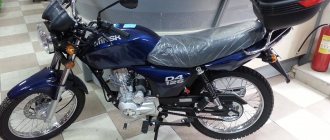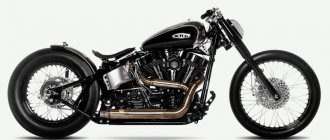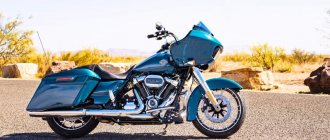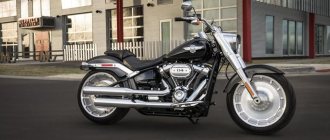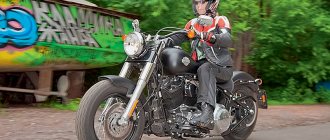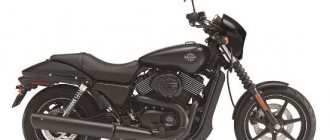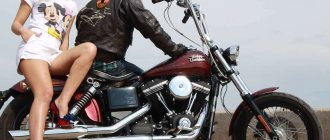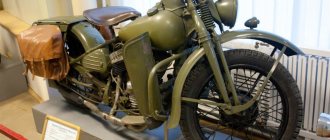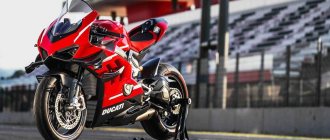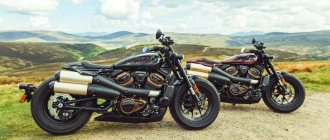Harley Davidson Low Rider
The series has been a commercial success since its introduction in 1977 as the FXS Low Rider, featuring alloy wheels, dual front brake discs and a low seat height of just 66 cm. The Low Rider was then transferred to the Dyna platform in 1993 and released as the FXDL. , having gained a new portion of people's love.
When the newest version of the Softail platform was introduced in 2021, the shocking news was that it had absorbed the Dyna platform, causing some panic among fans of the series' twin rear shock absorbers. The new Harley Davidson Low Rider, created on the Softail platform, was considered by fans of the brand to be an impostor, unworthy of attention.
Aftermarket prices for the Dyna Low Rider S immediately went up, even though the new Softail-based Low Rider is an all-around better bike.
Motorcycle FXS 1200 Low Rider (1978): technical specifications, photos, videos
new collection 1
| basic information | |
| Model: | Harley-Davidson FXS 1200 Low Rider |
| Year: | 1978 |
| Type: | Classic |
| Motor and drive | |
| Working volume: | 1206 cm 3 |
| Type: | V2 |
| Bars: | 4 |
| Power: | 58.00 hp (42.3 kW)) @ 5150 rpm |
| Compression: | 8.0:1 |
| Bore x Stroke: | 87.3 x 100.8 mm (3.4 x 4.0 inches) |
| Valves: | 2 |
| Bore x Stroke: | 87.3 x 100.8 mm (3.4 x 4.0 inches) |
| Fuel control: | OHV |
| Cooling: | Air |
| Transmission: | 4 speeds |
| Drive unit: | Chain |
| Speed and acceleration | |
| Max. speed: | 170.0 (105.6 mph) |
| Other | |
| Gas tank capacity: | 19 l. |
| Front tire: | 3.75-19 |
| Rear tire: | 5.10-16 |
| Front brake: | Double disc |
| Rear brake: | One disk |
Sorry, but this section is under construction, please check back later
Sorry, but this section is under construction, please check back later
Sorry, but this section is under construction, please check back later
Sorry, but this section is under construction, please check back later
Sorry, but this section is under construction, please check back later
Harley Davidson Softail Low Rider S 2021
Design
In the 2021 lineup, we will see the new Harley Davidson Softail Low Rider S, which will become a more powerful version of the Softail Low Rider with a larger engine, a sportier front end and a more hooligan character.
Harley Davidson Softail Low Rider S 2020
The look of the new Low Rider S builds on the heritage of the world's revered Low Riders from the '80s and the latest Dyna-based Low Rider S, says Brad Richards, vice president of styling and design at Harley Davidson. We've built a motorcycle with traditional styling and bold character on a Softail chassis, and our new Low Rider S is more powerful, agile and cool than ever.
Additional cool was achieved with a black finish covering almost all of the Low Rider's metal parts, reminiscent of the Dyna LR-S.
The list of black elements includes:
- The engine, final drive cover and tank stem are painted in textured Wrinkle Black
- Clutch cover, intake and valve cover bottoms are gloss black
- Mufflers and covers - Jet Black
- Fork, triple clamp, spacer, handlebars and rear fender mounts - matte black
The S version differs from the current Low Rider version by the increased cubic capacity of the Milwaukee-Eight engine (1868 cc versus the previous 1753), the peak torque is increased from 149 to 161 Nm (both by 3000 rpm).
The front of the motorcycle has become more sporty: in addition to the second brake disc, the motorcycle has acquired an inverted 43rd Showa fork. Thanks to a sharper fork offset angle (28 degrees), which slightly shortened the wheelbase from 163 to 161.5 cm, the motorcycle began to steer sharper. For comparison, the Dyna Low Rider had a laid-back fork with a 32-degree offset angle.
Performance lovers will undoubtedly appreciate the beefy forks and larger brakes of the 2021 Harley Davidson Softail Low Rider S, but you need to understand that they have also increased the weight by almost 6 kg according to official information. However, it’s unlikely that the extra pounds will be noticeable with such a cubic capacity, and with a slight movement of your hand you direct this monster to cut through the wind, which is helped by a new small windshield, another element that refers to the Dyna LR-S.
Landing in the spirit of the Sons of Anarchy - leaning forward with outstretched arms to a narrow one-inch handlebar on a 10-centimeter spacer. Harley dealers have repeatedly informed the factory that platforms are no longer in trend, and here is the answer - pegs with a neutral or even sharp knee angle.
The 2021 Harley Davidson Softail Low Rider S Solo Seat with High Backrest sits 67.3cm off the ground—only slightly higher than the standard Low Rider. It is quite soft and helps smooth out those bumps that the excellent Showa suspension with 86 mm of rear wheel travel cannot cope with. The spring preload of the monoshock absorber is set with a convenient hydraulic adjuster.
Harley Davidson Softail Low Rider S 2020
Our route included a long winding section, and the Harley Davidson Softail Low Rider S completed it at a good speed, taking into account the curb weight of 308 kg and more than one and a half meters of wheelbase. The narrow handlebar looks cool, but makes steering somewhat difficult: you have to control the motorcycle with a very conscious effort of your hands, and not with an “effort of thought.” The Softail's chassis is stable and doesn't wobble when cornering, inspiring confidence, and the maximum rake angle is 30.1 degrees—half a degree more than the standard Low Rider.
Brakes
The brakes are excellent for a cruiser - two four-piston Nissin calipers on 300 mm discs with steel (not rubber) lines. Feedback is crisp, if not exceptionally crisp, and the modulation is precise enough to produce a slight, controlled stall from the front wheel at will. However, stock ABS prevents all the undesirable consequences of playing with the brakes.
Engine
The Milwaukee-Eight engine continues to impress no matter what chassis it's in. The clutch is squeezed out quite easily for such a colossus, and the gearbox is soft, not counting the clunk between first and second. The Harley Davidson Softail Low Rider S engine produces excellent low-end thrust from 2000 rpm, and it increases powerfully and linearly until the cutoff of 5500.
Harley Davidson Softail Low Rider S 2020
The Milwaukee-Eight engine features two balancer shafts to reduce vibration, and rubber mounts eliminate vibration almost completely, even on a rigid chassis. It works almost as expected, minus minor vibrations that can be felt by the hands despite the fact that the steering wheel is also mounted on rubber pads. It seems that the extra volume, which gives more power, simply generates more powerful vibrations than on the 107 version.
Cons of the 2020 Harley Davidson Softail Low Rider S
Well, since we’re talking about minuses, I’ll mention that the tachometer on the remote tank is not very easy to read, because it is located practically under the rider’s stomach, and the heat from the exhaust is very felt by the right foot.
I personally would also prefer a shorter-throw throttle handle, so that I don’t have to twist my hand so much to fully open it.
Harley Davidson Softail Low Rider S 2020
Pros of the 2020 Harley Davidson Softail Low Rider S
From the cons to the pros of the 2020 Harley Davidson Softail Low Rider S: Let's praise Harley engineers for the deep velvety tone produced by the dual-barrel exhaust. It's loud enough to sound impressive, but not angry enough to be obnoxious - a great compromise in my opinion. I also liked the powerful levers that feel comfortable to squeeze with your fingertips, not to mention the excellent auto-off turn signals that keep you from looking like a crazy old man on the road, even if it's true.
Overall, I enjoyed my time in the saddle of the Harley Davidson Softail Low Rider S. It is full of hooligan character and practically devoid of flaws. If you're looking for a premium cruiser without panniers, the LR-S is definitely worth a look. The bike is available in Vivid Black and Barraduca Silver.
It’s not Russia here—custom vehicle operations (Custom Vehicle Operations) have never had any Harley tests. And then, lo and behold, they appeared. Not a CVO, of course, but still a 110 engine. From the very appearance of this model (and it belongs to the so-called 16.5 model year), I wanted to check it out on the road. And so the Prague dealership held a “demo day” in our remote regional center - we didn’t even have to go anywhere.
So, Dyna Low Rider S. The declared differences from the “civilian” version are that the engine has grown from 103 to 110 cc. inches (that's 1.8 liters), electronic throttle control, Screamin' Eagle Heavy Breather intake, 2 in 1 in 2 exhaust, small quarter fairing, all-black color with gold accents (a reference to the classic Sporty XLCR café racer from '77 ).
A very important difference is the premium suspension components “all around”. Even now I don’t understand why there is no “shifter” in front and why it was “given” to Breakout CVO, because Daina is our everything, club, 81st and Synovskaya. This car is part of the new S series, which, in addition to Low Rider S, also includes “Fat Man” and Softail Slim. This is the first time that the Company puts the 110 engine on NON-CVO motorcycles. Some believe that in this way we are being prepared for the fact that in 2021 the 110 will become the standard engine, and the CVO will receive the 120ST. We'll see, it won't be long before new models are announced. Maybe all this is chatter and instead of 110 we will get 107 with four valves per cylinder... Other “Eskies” are not interesting to me - they are Softails, which means Twincam Be, balancer shafts, loss of power.
It's all lyrics. Get behind the wheel! The ignition is keyless, as befits a 16 and a half year old car. All you have to do is have the key fob in your pocket, click the Run switch, and off you go. I immediately noticed that, like on the CVO, there is no nasty “butterfly” (the flap of the malicious Active Exhaust system). Therefore, both mufflers snort simultaneously, regardless of the gear engaged and engine speed. I must say that they snort excellently. The only standard mufflers that you don't want to immediately replace. Yes, you won’t be able to scare and push cars apart in traffic jams with a hellish roar, but on the move it sounds phenomenal - bassy and just moderately loud. We put a bold plus. It is not yet clear where the catalysts (or catalytic converter) are located - in the plugs or the manifold, but the Eska bakes its legs in the first place. Or is it the engine itself that warms up (thanks to environmentalists) - we’ll find out a little later when one of these motorcycles ends up on my operating table.
As I set off, I note the amazing agility. I also rode the 120th Daina, but it’s the “Eska” that GOES. I don’t understand where the legs come from - apparently, the components were selected extremely well. I always knew that Heavy Breather type filters provide a lot of torque, but in this case - yes! The motorcycle in its standard factory throttled version runs SOOOOOOOOOOOOOOOOOOOOOOOOOOOOOOOOOOOOOOOOOOOOOOOOOOOOOOOOOOOOOOOOOOOOOOOOOlls! There are no words, I can’t wait to lay my hands on one of these - it’s scary to think what will happen with good firmware.
I took it out onto a winding village road and was able to evaluate the suspension. Recently, the Company has pleased us (on some models) with shock absorbers that are terribly similar in appearance to Ohlins (gas-filled, stepless preload, threads on the body of the shock absorbers), and they ride well. In Harley tradition, produced by Showa. At the front, the Eski has a traditional telescopic fork with 49 mm stays and a Premium ride cartridge. On our roads, which were more like a washboard, the car took turns very well. True, I wanted to loosen the preload of the shock absorbers for my weight, it would be even better. One way or another - respect. This is not only better than everything that is on the “civilian” X-D motorcycles, it is better than what is installed at the factory on the CVO. I can't wait to see these shock absorbers adapted for Touring.
The engine pulls in any gear, but does not tolerate attempts to “pull it out from idle” - it immediately begins to ring, shake and die. It's okay, we can fix it. There were attempts to cough during acceleration (suboptimal ignition), but nothing criminal, “they all do it.” In any case, as I said, this is the best stock X-D motorcycle in terms of dynamics. Whether it plays a role that the motorcycle is 67 kg lighter than mine, or whether the “electronic gas” is tuned sharper straight from the factory, I don’t know yet, but the fact is that the car is very provocative, clinging to every opportunity to go fast. By the way, the Company declares 157 Nm of torque at 3500 rpm for this engine.
There were no roll bars on the motorcycle, so I used the brakes more often than I would like. Nothing unexpected here. “Esca” did not get Brembo, simple 4-piston brakes with ABS - two discs at the front and one at the rear. They work completely adequately, the ABS works smoothly, well, there’s nothing to say here. Brakes are like brakes. I just noticed, in comparison with the heavy Touring, that the wheel “squeals” a little when the ABS is working - the smaller mass affects it and the wheel manages to lock for the shortest moment. The rider's footpegs are in the middle here - midcontrols. I thought it would be uncomfortable, but the saddle moved me quite far back. Therefore, the legs were comfortable, but the arms had to stretch a little. For short hellish “takes” this is just right, but for long distances, if anything happens, you need to think about something. There is one more difference to note from the standard Low Rider. “Eska” is a purely SOLO motorcycle. I’m sure that any Dain double saddle will fit here, and the footpegs can easily be screwed on, you just have to keep this in mind when purchasing. The motorcycle corners quite predictably, despite the fact that the wheelbase is slightly longer (5 mm) than that of my King. I didn’t test the maximum tilt angles (we remember that there were no arches on the test motorcycle, but there was already a dent on the tank), and I didn’t have a chance to shuffle the footpegs. Thanks to its narrow front wheel, the Esca is more nimble than, say, its Fat Bob family mate. It turns around on a narrow road at a time, and it’s fine. The instruments and controls are quite traditional, the information displayed in the speedometer window is the same as that of any Daina with a CAN bus since 2012. There is a clock, an odometer, two daily mileage, mileage on remaining fuel and revolutions with gear. The analogue tachometer also shows the revolutions. Considering that both devices are located on the tank, there is absolutely no point in them. I admit that I blew the cruise control, which is in the specifications, did not try it in action and did not even notice the lever under the left remote control.
(the photo is not mine, but from the Motorcyclist online website)
I will draw exactly one conclusion. I haven't been so pleasantly surprised for a long time. I won’t buy this Daina, because I already have a motorcycle, a universal one, suitable for any occasion. But for someone who really NEEDS a second motorcycle, the Dyna Low Rider S is a great option. I didn’t notice any obvious shortcomings, except for the engine being hot due to the lean mixture and the catalyst/s. Also, if I'm being picky, it's the headlight. Such a fast car needs to shine FAR, but here we have a simple Sportster flashlight with a diameter of 5 3/4 inches.
Tuning and repair
One of the reasons for the incredible popularity of this brand all over the world is the truly immense possibilities for tuning and simple repairs. Any Harley-Davidson is a construction set for adult men, in which everything can be replaced. Do you want a new engine with a capacity of about two and a half liters? Easily. New transmission? Please. Wheels, seats, fenders, body kit, gas tanks, carburetors and injectors... Absolutely everything in this motorcycle can be replaced if you have enough money. Moreover, in addition to the official tuning catalog, Dyna parts are also produced by dozens of other manufacturers.
Repairing the bike is also easy. The only peculiarity is the inch system. Models of recent years, officially sold by Russian dealers, are already equipped with metric bolts and nuts, but those copies imported here from the USA are still inch. In practice, this only means that you will have to acquire a set of American tools. But this doesn’t make it any more difficult to maintain or repair your favorite motorcycle.
